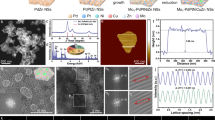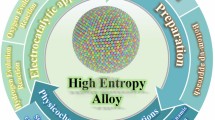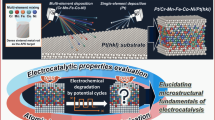Abstract
High-entropy alloys (HEAs) have been widely studied due to their unconventional compositions and unique physicochemical properties for various applications. Herein, for the first time, we propose a surface strain strategy to tune the electrocatalytic activity of HEAs for methanol oxidation reaction (MOR). High-resolution aberration-corrected scanning transmission electron microscopy (STEM) and elemental mapping demonstrate both uniform atomic dispersion and the formation of a face-centered cubic (FCC) crystalline structure in PtFeCoNiCu HEAs. The HEAs obtained by heat treatment at 700°C (HEA-700) exhibit 0.94% compressive strain compared with that obtained at 400°C (HEA-400). As expected, the specific activity and mass activity of HEA-700 is higher than that of HEA-400 and most of the state-of-the-art catalysts. The enhanced MOR activity can be attributed to a shorter Pt-Pt bond distance in HEA-700 resulting from compressive strain. The nonprecious metal atoms in the core could generate compressive strain and down shift d-band centers via electron transfer to surface Pt layer. This work presents a new perspective for the design of high-performance HEAs electrocatalysts.

摘要
高熵合金(HEAs)因其非常规的组成和独特的物理化学性质 而得到广泛研究. 本文, 我们首次提出了一种表面应变策略来调控 HEAs的电子结构用于高效的甲醇电氧化反应(MOR). 高分辨像差 校正扫描透射电子显微镜(STEM)和元素分布分析表明, 在PtFeCo-NiCu HEAs中各原子分散均匀, 并形成FCC晶体结构. 700°C热处理 所得HEA-700的压缩应变比400°C热处理所得HEA-400的压缩应变 高0.94%. 正如预期, HEA-700的比活性和质量活性远超HEA-400和 目前大多数最先进的催化剂. MOR活性的增强归因于压缩应变导 致HEA-700中Pt–Pt键距缩短. 同时, 核中的非贵金属原子通过转移 电子到表面Pt层产生压缩应变和d带中心的下移. 这项工作为高性 能HEAs电催化剂的设计提供了一个新的视角.
Similar content being viewed by others
References
Zeb Gul Sial MA, Ud Din MA, Wang X. Multimetallic nanosheets: Synthesis and applications in fuel cells. Chem Soc Rev, 2018, 47: 6175–6200
Zhang W, Yang Y, Huang B, et al. Ultrathin PtNiM (M = Rh, Os, and Ir) nanowires as efficient fuel oxidation electrocatalytic materials. Adv Mater, 2019, 31: 1805833
Xia BY, Wu HB, Li N, et al. One-pot synthesis of Pt-Co alloy nanowire assemblies with tunable composition and enhanced electrocatalytic properties. Angew Chem Int Ed, 2015, 54: 3797–3801
Li J, Jilani SZ, Lin H, et al. Ternary CoPtAu nanoparticles as a general catalyst for highly efficient electro-oxidation of liquid fuels. Angew Chem Int Ed, 2019, 58: 11527–11533
Rethinasabapathy M, Kang SM, Haldorai Y, et al. Quaternary PtRuFeCo nanoparticles supported N-doped graphene as an efficient bifunctional electrocatalyst for low-temperature fuel cells. J Ind Eng Chem, 2019, 69: 285–294
Lei Z, Liu X, Wu Y, et al. Enhanced strength and ductility in a high-entropy alloy via ordered oxygen complexes. Nature, 2018, 563: 546–550
Ding Q, Zhang Y, Chen X, et al. Tuning element distribution, structure and properties by composition in high-entropy alloys. Nature, 2019, 574: 223–227
El-Atwani O, Li N, Li M, et al. Outstanding radiation resistance of tungsten-based high-entropy alloys. Sci Adv, 2019, 5: eaav2002
Yao Y, Huang Z, Xie P, et al. Carbothermal shock synthesis of high-entropy-alloy nanoparticles. Science, 2018, 359: 1489–1494
Yang T, Zhao YL, Tong Y, et al. Multicomponent intermetallic nanoparticles and superb mechanical behaviors of complex alloys. Science, 2018, 362: 933–937
Bondesgaard M, Broge NLN, Mamakhel A, et al. General solvothermal synthesis method for complete solubility range bimetallic and high-entropy alloy nanocatalysts. Adv Funct Mater, 2019, 29: 1905933
Cantor B, Chang ITH, Knight P, et al. Microstructural development in equiatomic multicomponent alloys. Mater Sci Eng-A, 2004, 375–377: 213–218
Yeh JW, Chen SK, Lin SJ, et al. Nanostructured high-entropy alloys with multiple principal elements: Novel alloy design concepts and outcomes. Adv Eng Mater, 2004, 6: 299–303
Zhang Y, Zuo TT, Tang Z, et al. Microstructures and properties of high-entropy alloys. Prog Mater Sci, 2014, 61: 1–93
Tsai KY, Tsai MH, Yeh JW. Sluggish diffusion in Co-Cr-Fe-Mn-Ni high-entropy alloys. Acta Mater, 2013, 61: 4887–4897
Yeh JW, Chang SY, Hong YD, et al. Anomalous decrease in X-ray diffraction intensities of Cu-Ni-Al-Co-Cr-Fe-Si alloy systems with multi-principal elements. Mater Chem Phys, 2007, 103: 41–46
Zhang W, Liaw PK, Zhang Y. Science and technology in high-entropy alloys. Sci China Mater, 2018, 61: 2–22
Lacey SD, Dong Q, Huang Z, et al. Stable multimetallic nano-particles for oxygen electrocatalysis. Nano Lett, 2019, 19: 5149–5158
Qiu HJ, Fang G, Wen Y, et al. Nanoporous high-entropy alloys for highly stable and efficient catalysts. J Mater Chem A, 2019, 7: 6499–6506
Qiu HJ, Fang G, Gao J, et al. Noble metal-free nanoporous high-entropy alloys as highly efficient electrocatalysts for oxygen evolution reaction. ACS Mater Lett, 2019, 1: 526–533
Luo M, Guo S. Strain-controlled electrocatalysis on multimetallic nanomaterials. Nat Rev Mater, 2017, 2: 17059
Wang H, Xu S, Tsai C, et al. Direct and continuous strain control of catalysts with tunable battery electrode materials. Science, 2016, 354: 1031–1036
Strasser P, Koh S, Anniyev T, et al. Lattice-strain control of the activity in dealloyed core-shell fuel cell catalysts. Nat Chem, 2010, 2: 454–460
Qin Y, Zhang W, Guo K, et al. Fine-tuning intrinsic strain in penta-twinned Pt-Cu-Mn nanoframes boosts oxygen reduction catalysis. Adv Funct Mater, 2020, 30: 1910107
Bu L, Zhang N, Guo S, et al. Biaxially strained PtPb/Pt core/shell nanoplate boosts oxygen reduction catalysis. Science, 2016, 354: 1410–1414
Wang D, Xin HL, Hovden R, et al. Structurally ordered intermetallic platinum-cobalt core-shell nanoparticles with enhanced activity and stability as oxygen reduction electrocatalysts. Nat Mater, 2013, 12: 81–87
Chen L, Zhu J, Xuan C, et al. Effects of crystal phase and composition on structurally ordered Pt-Co-Ni/C ternary intermetallic electrocatalysts for the formic acid oxidation reaction. J Mater Chem A, 2018, 6: 5848–5855
Wei PC, Liao CN, Wu HJ, et al. Thermodynamic routes to ultralow thermal conductivity and high thermoelectric performance. Adv Mater, 2020, 32: 1906457
Lee C, Kim G, Chou Y, et al. Temperature dependence of elastic and plastic deformation behavior of a refractory high-entropy alloy. Sci Adv, 2020, 6: eaaz4748
Sonkusare R, Swain A, Rahul MR, et al. Establishing processing-microstructure-property paradigm in complex concentrated equiatomic CoCuFeMnNi alloy. Mater Sci Eng-A, 2019, 759: 415–429
Broge NLN, Bondesgaard M, Søndergaard-Pedersen F, et al. Autocatalytic formation of high-entropy alloy nanoparticles. Angew Chem Int Ed, 2020, 59: 21920–21924
Li C, Yuan Q, Ni B, et al. Dendritic defect-rich palladium-copper-cobalt nanoalloys as robust multifunctional non-platinum electrocatalysts for fuel cells. Nat Commun, 2018, 9: 3702
Wang L, Yamauchi Y. Metallic nanocages: Synthesis of bimetallic Pt-Pd hollow nanoparticles with dendritic shells by selective chemical etching. J Am Chem Soc, 2013, 135: 16762–16765
Dutta A, Ouyang J. Ternary NiAuPt nanoparticles on reduced graphene oxide as catalysts toward the electrochemical oxidation reaction of ethanol. ACS Catal, 2015, 5: 1371–1380
Becknell N, Kang Y, Chen C, et al. Atomic structure of Pt3Ni nanoframe electrocatalysts by in situ X-ray absorption spectroscopy. J Am Chem Soc, 2015, 137: 15817–15824
Jiang K, Wang P, Guo S, et al. Ordered PdCu-based nanoparticles as bifunctional oxygen-reduction and ethanol-oxidation electrocatalysts. Angew Chem Int Ed, 2016, 55: 9030–9035
Zhang J, Qu X, Han Y, et al. Engineering PtRu bimetallic nanoparticles with adjustable alloying degree for methanol electrooxidation: Enhanced catalytic performance. Appl Catal B-Environ, 2020, 263: 118345
Wang H, Wang J, Pi Y, et al. Double perovskite LaFexNi1−xO3 nanorods enable efficient oxygen evolution electrocatalysis. Angew Chem Int Ed, 2019, 58: 2316–2320
Li YH, Xing J, Chen ZJ, et al. Unidirectional suppression of hydrogen oxidation on oxidized platinum clusters. Nat Commun, 2013, 4: 2500
Cheng X, Li Y, Zheng L, et al. Highly active, stable oxidized platinum clusters as electrocatalysts for the hydrogen evolution reaction. Energy Environ Sci, 2017, 10: 2450–2458
Senkov ON, Senkova SV, Dimiduk DM, et al. Oxidation behavior of a refractory NbCrMo0.5Ta0.5TiZr alloy. J Mater Sci, 2012, 47: 6522–6534
He C, Tao J. Pt loaded two-dimensional TaC-nanosheet/graphene hybrid as an efficient and durable electrocatalyst for direct methanol fuel cells. J Power Sources, 2016, 324: 317–324
Shao M, Chang Q, Dodelet JP, et al. Recent advances in electrocatalysts for oxygen reduction reaction Chem Rev, 2016, 116: 3594–3657
Wang Q, Zhao Q, Su Y, et al. Hierarchical carbon and nitrogen adsorbed PtNiCo nanocomposites with multiple active sites for oxygen reduction and methanol oxidation reactions. J Mater Chem A, 2016, 4: 12296–12307
Jia Q, Zhao Z, Cao L, et al. Roles of Mo surface dopants in Enhancing the ORR performance of octahedral PtNi nanoparticles Nano Lett, 2018, 18: 798–804
Zhang Y, Shi Y, Chen R, et al. Enriched nucleation sites for Pt deposition on ultrathin WO3 nanosheets with unique interactions for methanol oxidation J Mater Chem A, 2018, 6: 23028–23033
Xue S, Deng W, Yang F, et al. Hexapod PtRuCu nanocrystalline alloy for highly efficient and stable methanol oxidation ACS Catal, 2018, 8: 7578–7584
Wang Q, Chen S, Li P, et al. Surface Ru enriched structurally ordered intermetallic PtFe@PtRuFe core-shell nanostructure boosts methanol oxidation reaction catalysis. Appl Catal B-Environ, 2019, 252: 120–127
Wu G, Li L, Xu BQ. Effect of electrochemical polarization of PtRu/C catalysts on methanol electrooxidation. Electrochim Acta, 2004, 50: 1–10
Gorle DB, Velacheri Kumman V, Kulandainathan MA. Highly efficient, large surface area and spherically shaped Pt particles deposited electrolytically synthesized graphene for methanol oxidation with impedance spectroscopy. Int J Hydrogen Energy, 2017, 42: 16258–16268
Hsing IM, Wang X, Leng YJ. Electrochemical impedance studies of methanol electro-oxidation on Pt/C thin film electrode J Electrochem Soc, 2002, 149: A615
Chen W, Kim J, Sun S, et al. Composition effects of FePt alloy nanoparticles on the electro-oxidation of formic acid Langmuir, 2007, 23: 11303–11310
Zhang Y, Qiao M, Huang Y, et al. In situ exfoliation and Pt deposition of antimonene for formic acid oxidation via a predominant dehydrogenation pathway. Research, 2020, 2020: 1–11
Chen W, Kim J, Sun S, et al. Electro-oxidation of formic acid catalyzed by FePt nanoparticles Phys Chem Chem Phys, 2006, 8: 2779–2786
Li J, Sharma S, Liu X, et al. Hard-magnet L10-CoPt nanoparticles advance fuel cell catalysis. Joule, 2019, 3: 124–135
Lu Z, Chen ZW, Singh CV Neural network-assisted development of high-entropy alloy catalysts: Decoupling ligand and coordination effects Matter, 2020, 3: 1318–1333
Acknowledgements
This work was supported by the National Natural Science Foundation of China (51402100, 21573066, 21825201, 22002039, and 21522305), the Scientific Research Foundation of Hunan Provincial Education Department (19C0054), the Postgraduate Scientific Research Innovation Project of Hunan Province (CX20200441), the Australian Research Council (CE 140100012)∣ the Australian National Fabrication Facility ∣ UOW Electron Microscopy Centre, and Compute Canada, Natural Sciences and Engineering Research Council of Canada (NSERC), University of Toronto.
Author information
Authors and Affiliations
Contributions
Wang S, Singh CV, Tao L, Zhang Y, Chen J and Dong CL conceived the idea and directed the research Wang D, Chen Z, Huang YC and Li W designed the experiments. Wang D, Li W, Wang J, Gu K, Huang X, Chen J and Wang T synthesized the materials and carried out the XRD, XPS, TEM and STEM physical characterizations. Huang Y and Dong CL did the XANES and EXAFS experiments. Wang D, Zhang Y, Wu Y and Chen C completed the electrochemical tests. Chen Z, Lu Z and Singh CV provided the DFT calculation for this work Wang D, Chen Z, Huang YC and Li W wrote the paper with comments from all authors
Corresponding authors
Additional information
Conflict of interest
The authors declare that they have no conflict of interest
Supplementary information
Supporting data are available in the online version of the paper
Dongdong Wang received his Bachelor degree in 2018 from Hunan University of Science and Technology, China. He is currently pursuing his PhD degree under the supervision of Prof. Shuangyin Wang at Hunan University. His research interest includes the synthesis, characterization of nanomaterials for electrocatalysis and electrochemical coupling.
Zhiwen Chen works as a postdoctoral fellow in the Department of Materials Science and Engineering (MSE) at the University of Toronto, Canada. He received his PhD degree from Jilin University, China. His current research focuses on the catalyst design for hydrogen evolution reaction, CO2 reduction reaction, nitrogen reduction reaction, etc. through density functional theory calculations. Some of his studies are carried out in close collaboration with experiments.
Yu-Cheng Huang received his BSc degree from Tamkang University in 2015, and obtained his MSc degree in the Department of Electrophysics from Chiao Tung University in 2017. He started studying for PhD in the Department of Electrophysics, Chiao Tung University in 2017. His research focuses on fundamental XAS analysis, including XANES, EXAFS and soft X-ray in-situ measurement techniques.
Wei Li received his BSc degree in 2013 from Huazhong Agricultural University and his PhD degree in 2018 from Chongqing University under the supervision of Prof. Zidong Wei. He currently works at Hunan University as a postdoctoral researcher under the co-supervision of Prof. Shuangyin Wang. His main research focuses on the development of defective nanomaterials in fuel cell application.
Yiqiong Zhang received her Master degree in 2015 from South China Normal University and her PhD degree in 2019 from Hunan University under the supervision of Prof. Shuangyin Wang. She is currently working at the College of Materials Science and Engineering, Changsha University of Science & Technology. Her current research interests include the synthesis and characterization of nanomaterials with various defects for electrochemical energy conversion and storage technologies.
Li Tao received his Master degree in 2016 and his PhD degree in 2019 from Hunan University under the supervision of Prof. Shuangyin Wang. He is currently an assistant professor of the key Laboratory for Graphene Materials and Devices and College of Chemistry and Chemical Engineering, Hunan University. His research interests are in plasma technology, defect chemistry and fuel cell.
Chung-Li Dong received his PhD degree in physics from Tamkang University in 2004. He then worked as a postdoctoral fellow at the Advanced Light Source Facility (Lawrence Berkeley National Laboratory) with Prof. Jinghua Guo. Now he joined the Department of Physics at Tamkang University as Associate Professor. His current research interests include the development of electrochromic, gaschromic and thermochromic related soft/hard X-ray in-situ reactors, lithium battery systems, supercapacitor systems, and electrocatalytic hydrogen production catalysts.
Jun Chen received his PhD degree at the School of Chemistry, University of Wollongong, Australia, in 2003. Professor Chen is a Chief Investigator of The ARC Centre of Excellence for Electromaterials Science (ACES). His research interests include sustainable energy devices/systems, electro-/bio- interfaces, nano/micro-materials, 2D/3D printing, and design and fabrication of smart electronic devices.
Chandra Veer Singh is the Erwin Edward Hart Endowed Associate Professor and Associate Chair of Research in the Department of Materials Science and Engineering at the University of Toronto, Canada. Dr Singh received his PhD degree in aerospace engineering from Texas A&M University. Subsequently, he worked as a postdoctoral fellow at Cornell University. His research is currently focused on the atomistic modeling and machine learning enabled development of new materials for catalysts and metal-ion batteries.
Shuangyin Wang received his BSc degree in 2006 from Zhejiang University and his PhD degree in 2010 from Nanyang Technological University, Singapore. He is currently a professor of the Key Laboratory for Graphene Materials and Devices and College of Chemistry and Chemical Engineering, Hunan University. His research interests are in plasma technology, defects in various crystals and their application for electrochemical energy storage and conversion.
Rights and permissions
About this article
Cite this article
Wang, D., Chen, Z., Huang, YC. et al. Tailoring lattice strain in ultra-fine high-entropy alloys for active and stable methanol oxidation. Sci. China Mater. 64, 2454–2466 (2021). https://doi.org/10.1007/s40843-020-1635-9
Received:
Accepted:
Published:
Issue Date:
DOI: https://doi.org/10.1007/s40843-020-1635-9




